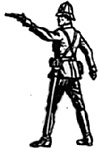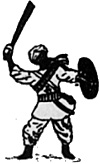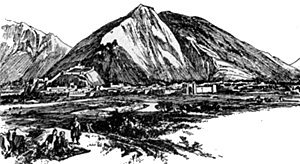 Throughout the days of the British Raj in India a large army was deployed on the North-West
Frontier of India, always mobilised for active service. After the Afghan War of 1879 there was no heavy fighting on the frontier for some years as the tribes, while never quite at peace, did not provoke another large expedition until October 1888. Then it was necessary to march a whole division of troops into the Black Mountains at the northern extremity of the North-West Frontier, a region never before penetrated by the British. In an arduous but not costly campaign the British returned after a few skirmishes with the loss of 25 soldiers.
Throughout the days of the British Raj in India a large army was deployed on the North-West
Frontier of India, always mobilised for active service. After the Afghan War of 1879 there was no heavy fighting on the frontier for some years as the tribes, while never quite at peace, did not provoke another large expedition until October 1888. Then it was necessary to march a whole division of troops into the Black Mountains at the northern extremity of the North-West Frontier, a region never before penetrated by the British. In an arduous but not costly campaign the British returned after a few skirmishes with the loss of 25 soldiers.
At 5.30 a.m. on the very dark night of the 2nd of November, 1894, the camp at Wana was suddenly roused by three shots followed by wild yells and the beating of drums. At the same time a desperate rush of some 500 fanatics over-ran the left flank and rear of the camp. Rushing in quickly, they were over the defences and into the middle of the camp before the Gurkhas could turn out of their tents.
 Under cover of darkness, the enemy had crept up two large ravines to the West, rushed the picquets (one of which had fired three alarm shots) and charged straight down into the camp. Another party breaking in at the rear did much damage among the transport, freeing the horses in the hope of causing a stampede.
Under cover of darkness, the enemy had crept up two large ravines to the West, rushed the picquets (one of which had fired three alarm shots) and charged straight down into the camp. Another party breaking in at the rear did much damage among the transport, freeing the horses in the hope of causing a stampede.
The Gurkhas rallied and eventually drove the enemy from their part of the camp; the reserve of the regiment formed a rallying square in their camp and fought hand-to-hand with the enemy. The enemy made two further attacks from the same direction but were beaten off as the infantry got in several effective volleys by the light of star-shells.
The following account, which is divided into two parts, deals with a skirmish action at Gor Khatri market place in the old part of Peshawar, headquarters of the Punjab Frontier Force and of a brigade of the Bengal Army; it was also the nearest town in the British Administrative Area to the lawless regions of the Khyber Pass.
 Part I describes the situation in which Sub-Lieutenant the Honourable Edwin Allardyce found himself one sunny day in August 1874 and Part II indicates how the situation was re-enacted as a wargame - and the results thereof.
Part I describes the situation in which Sub-Lieutenant the Honourable Edwin Allardyce found himself one sunny day in August 1874 and Part II indicates how the situation was re-enacted as a wargame - and the results thereof.
Gor Khatri was originally a place of pilgrimage for Hindus who came from many miles away to shave off their locks as a sign of devotion but on this occasion it was a Moslem - the notorious outlaw Bahram Khan - who had a close shave.
Victorian Campaigns on the Northwest Frontier
Part II: If Anyone Can, Bahram Khan (WN 155)
Back to Table of Contents -- Wargamer's Newsletter # 154
To Wargamer's Newsletter List of Issues
To MagWeb Master Magazine List
© Copyright 1975 by Donald Featherstone.
This article appears in MagWeb (Magazine Web) on the Internet World Wide Web.
Other military history articles and gaming articles are available at http://www.magweb.com